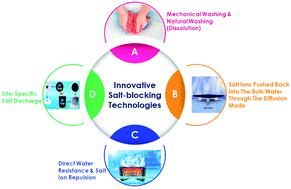Innovative salt-blocking technologies of photothermal materials in solar-driven interfacial desalination
Abstract
In recent decades, the rapid development of solar water evaporation has been achieved, focusing on low-cost and energy water desalination. For this purpose, different photothermal materials have been introduced, which promise new techniques in the field of freshwater production. This rapid development has given birth to novel technologies involving photothermal materials that use minimum energy with low cost and exceptional efficacy. These design architectures enhance the evaporation performance substantially. Herein, we systemically present the recent progress in this field. The major challenge faced by photothermal materials is the accumulation of salt crystals on their surface due to their continuous operation in salty water, which increases the reflection of light and blocks their channels for steam evaporation. This reduces the absorption efficiency of photothermal materials and results in a reduction in the evaporation efficiency with time. Particularly, different innovative photothermal material technologies and salt rejection techniques are highlighted, including mechanical washing and natural washing (dissolution), pushing salt ions back into the bulk water through the diffusion mode, direct water resistance and salt ion repulsion and site-specific salt discharge. Finally, the perspectives of advanced salt-blocking technologies for practical long-term solar desalination are proposed.



 Please wait while we load your content...
Please wait while we load your content...